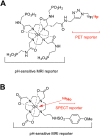Potential clinical applications of bimodal PET-MRI or SPECT-MRI agents
- PMID: 24395384
- PMCID: PMC4336561
- DOI: 10.1002/jlcr.3154
Potential clinical applications of bimodal PET-MRI or SPECT-MRI agents
Abstract
The introduction to the clinic of positron emission tomography-magnetic resonance imaging scanners opens up the possibility to evaluate the real potential of bimodal imaging agents. In this mini-review, the limitations in the design and applications of these materials are summarised and the unique properties that may result in real clinical applications outlined.
Keywords: PET-MRI; SPECT-MRI; SPIO; medical imaging; multimodal agents.
© 2014 The Authors. Labelled Compounds and Radiopharmaceuticals published by John Wiley.
Figures






References
-
- Shao YP, Cherry SR, Farahani K, Meadors K, Siegel S, Silverman RW, Marsden PK. Phys. Med. Biol. 2008;42:1965. - PubMed
-
- Judenhofer MS, Wehrl HF, Newport DF, Catana C, Siegel SB, Becker M, Thielscher A, Kneilling M, Lichy MP, Eichner M, Klingel K, Reischl G, Widmaier S, Rocken M, Nutt RE, Machulla HJ, Uludag K, Cherry SR, Claussen CD, Pichler BJ. Nat. Med. 1997;14 - PubMed
-
- Herzog H. Z. Med. Phys, 2008. 2012;22 - PubMed
-
- Poulin E, Lebel R, Croteau E, Blanchette M, Tremblay L, Lecomte R, Bentourkia M, Lepage M. Mag. Reson. Med. 2013;69:781. - PubMed
Publication types
MeSH terms
Grants and funding
LinkOut - more resources
Full Text Sources
Other Literature Sources
Medical

